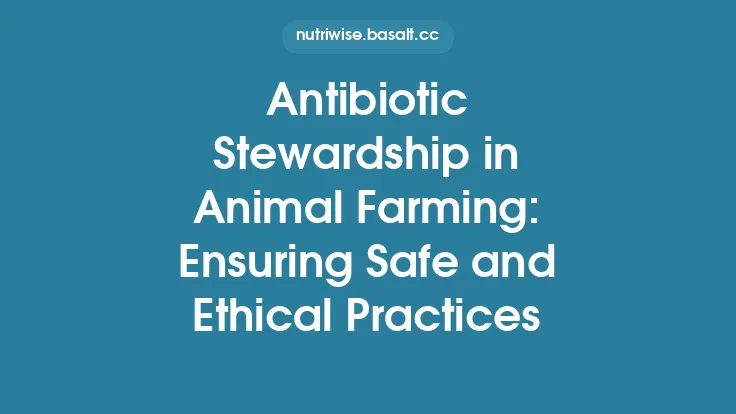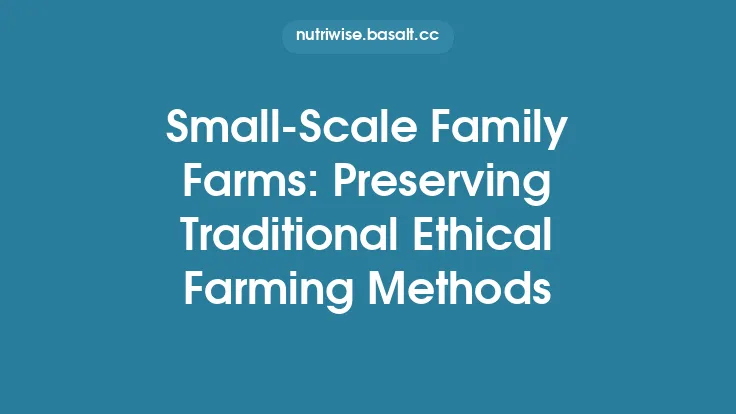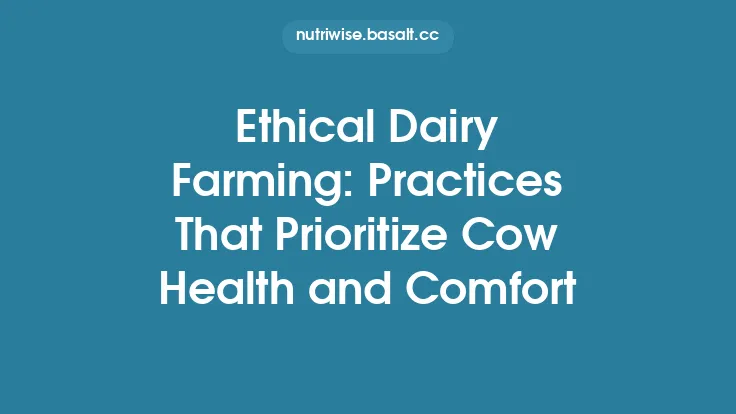Humane animal husbandry is the foundation upon which ethical, sustainable food systems are built. By treating livestock as sentient beings with intrinsic needs, producers can improve animal health, product quality, and public trust. This article outlines the essential principles that define humane husbandry, offering a comprehensive guide for farmers, veterinarians, policymakers, and anyone interested in responsible animal agriculture.
Core Pillars of Humane Husbandry
Humane husbandry rests on a set of interrelated pillars that together create an environment where animals can thrive:
| Pillar | Primary Goal | Key Actions |
|---|---|---|
| Nutrition | Meet species‑specific dietary requirements for growth, reproduction, and maintenance. | Formulate balanced rations, provide clean water, and adjust feed according to life stage. |
| Housing | Offer shelter that protects from weather extremes, predators, and disease vectors. | Design structures with appropriate ventilation, temperature control, and space allowances. |
| Health Management | Prevent disease and alleviate suffering through proactive care. | Implement vaccination schedules, regular health checks, and prompt treatment of injuries. |
| Behavioral Freedom | Allow expression of natural behaviors essential for mental well‑being. | Provide enrichment, social grouping, and space for movement. |
| Reproduction & Genetics | Ensure breeding practices respect animal welfare and genetic diversity. | Use selective breeding responsibly, avoid excessive inbreeding, and manage breeding cycles to prevent stress. |
| Humane End‑of‑Life Practices | Minimize pain and distress during transport, slaughter, or euthanasia. | Follow scientifically validated stunning methods and humane euthanasia protocols. |
These pillars are not isolated; they interact dynamically. For example, proper nutrition reduces disease susceptibility, which in turn eases the burden on health management systems.
Providing Species‑Specific Nutrition and Hydration
1. Understanding Nutrient Requirements
Each livestock species—and even different breeds within a species—has unique macronutrient (protein, energy, fiber) and micronutrient (vitamins, minerals) needs. Modern nutrition science uses the Nutrient Requirements of Domestic Animals (NRC) guidelines to calculate precise dietary formulations.
- Protein: Essential for tissue repair and growth. Ruminants (cattle, sheep, goats) rely on microbial protein synthesis in the rumen, while monogastrics (poultry, swine) require high‑quality dietary protein.
- Energy: Delivered primarily through carbohydrates and fats. Over‑feeding energy can lead to metabolic disorders such as fatty liver in laying hens or ketosis in dairy cows (though dairy specifics are avoided, the principle applies to lactating animals generally).
- Fiber: Critical for rumen health; inadequate fiber can cause ruminal acidosis. For non‑ruminants, fiber aids gut motility.
2. Water Quality and Access
Clean, fresh water is a non‑negotiable requirement. Water intake influences feed conversion efficiency, thermoregulation, and overall health. Systems should:
- Provide multiple access points to reduce competition.
- Ensure temperature control in extreme climates (e.g., heated troughs in winter).
- Regularly test for contaminants (e.g., nitrates, pathogens).
3. Feeding Management Practices
- Phase Feeding: Adjust rations as animals progress through growth, gestation, or lactation phases.
- Feed Delivery: Use automated feeders to reduce human‑animal contact that could cause stress, while ensuring consistent feed availability.
- Monitoring Intake: Employ electronic feed intake monitoring to detect early signs of illness (e.g., reduced consumption).
Designing Safe and Comfortable Housing
1. Space Allocation
Adequate floor space per animal is essential to prevent overcrowding, which can lead to aggression, injuries, and disease spread. Guidelines often reference stocking density metrics:
- Poultry: Minimum of 0.1 m² per bird for broilers, with additional space for perches.
- Swine: At least 0.65 m² per market-weight pig in pens.
- Cattle: Minimum of 1.5 m² per adult animal in indoor housing.
2. Environmental Control
- Ventilation: Proper airflow removes excess heat, moisture, and ammonia. Mechanical ventilation systems should be calibrated to maintain indoor temperatures within the species’ thermoneutral zone.
- Temperature Regulation: Insulation, radiant heating, and cooling pads help maintain stable temperatures, reducing heat stress or hypothermia.
- Lighting: Natural daylight cycles support circadian rhythms. Supplemental lighting should mimic natural photoperiods to avoid reproductive disruptions.
3. Flooring and Bedding
- Floor Type: Slatted floors facilitate waste removal but can cause foot lesions if not properly designed. Solid floors with appropriate bedding (e.g., straw, wood shavings) provide comfort and reduce pressure sores.
- Bedding Management: Regular replacement and proper depth prevent moisture buildup, which can harbor pathogens.
4. Biosecurity Integration
Housing design should incorporate biosecurity measures without compromising animal welfare:
- Physical Barriers: Controlled entry points, footbaths, and dedicated equipment for each animal group.
- Air Filtration: HEPA filters in high‑risk areas to limit airborne pathogen transmission.
Facilitating Natural Behaviors and Enrichment
Animals possess innate behavioral repertoires that, when suppressed, can lead to frustration, stereotypies, and reduced welfare.
1. Social Structures
- Group Housing: Many species are social; maintaining stable groups reduces aggression. For example, pigs form hierarchical structures; stable groups minimize fighting.
- Segregation When Needed: Separate individuals showing signs of illness or aggression to protect the herd.
2. Environmental Enrichment
Enrichment can be physical, sensory, or cognitive:
- Physical: Perches for chickens, rooting substrates for pigs, and scratching posts for goats.
- Sensory: Varied lighting, natural sounds, or scent cues (e.g., herbs) to stimulate curiosity.
- Cognitive: Puzzle feeders that require problem‑solving to access food, encouraging mental stimulation.
3. Exercise Opportunities
- Outdoor Access: When feasible, provide pasture or paddock time to allow natural locomotion.
- Indoor Exercise Areas: Rotating pens with varied terrain (ramps, platforms) encourages movement.
Health Management and Preventive Care
A proactive health strategy reduces the need for therapeutic interventions and aligns with humane principles.
1. Vaccination Protocols
Vaccines protect against common infectious agents (e.g., porcine circovirus, avian influenza). Protocols should be:
- Species‑specific.
- Timed to coincide with critical life stages (e.g., before breeding or weaning).
2. Routine Health Monitoring
- Physical Exams: Regular checks for lameness, skin lesions, and body condition scoring.
- Diagnostic Tools: Use of ultrasonography, endoscopy, and blood panels to detect subclinical disease.
- Digital Health Records: Centralized databases enable trend analysis and early outbreak detection.
3. Parasite Control
Implement integrated parasite management (IPM) that combines pasture rotation (where applicable), strategic deworming, and fecal egg count monitoring to avoid over‑reliance on chemical treatments.
4. Pain Management
When procedures are necessary (e.g., castration, dehorning), employ analgesics and anesthetics in accordance with veterinary guidelines to mitigate pain.
Ethical Breeding and Genetic Considerations
Breeding decisions have long‑term welfare implications.
1. Selecting for Health and Robustness
Prioritize traits such as disease resistance, fertility, and structural soundness over purely production‑focused traits (e.g., extreme muscle mass) that can predispose animals to health problems.
2. Managing Inbreeding
- Genetic Diversity: Maintain a broad genetic base to reduce the incidence of hereditary disorders.
- Pedigree Tracking: Use software to monitor relatedness and avoid close matings.
3. Reproductive Management
- Estrus Synchronization: Apply only when it improves welfare (e.g., reducing the number of breeding attempts).
- Gestation Length Monitoring: Avoid forced early or delayed parturition, which can cause neonatal mortality.
Humane Handling and Transport Practices
While low‑stress handling is a specialized topic, the broader principle of minimizing distress during movement and transport remains essential.
1. Facility Layout
Design pathways that avoid sharp turns, steep inclines, and slippery surfaces. Use non‑slip flooring and gentle gradients to reduce the risk of falls.
2. Loading and Unloading
- Gradual Introduction: Allow animals to acclimate to loading ramps or chutes before moving them.
- Adequate Lighting: Ensure sufficient illumination to prevent hesitation or panic.
3. Transport Conditions
- Space Allocation: Provide enough room for animals to stand without being pressed against each other.
- Ventilation: Maintain airflow to prevent heat buildup.
- Journey Duration: Limit transport times and provide rest periods for long distances.
4. Emergency Protocols
Equip transport vehicles with first‑aid kits and have trained personnel ready to address injuries or health emergencies promptly.
Monitoring Welfare and Data‑Driven Decision Making
Continuous assessment is vital for maintaining humane standards.
1. Welfare Indicators
- Behavioral: Frequency of natural behaviors (e.g., foraging, dust‑bathing) versus abnormal behaviors (e.g., pecking, tail biting).
- Physiological: Cortisol levels, heart rate variability, and immune markers.
- Productivity: Mortality rates, growth performance, and reproductive success.
2. Technology Integration
- Sensors: Wearable devices that track movement, temperature, and rumination.
- Video Analytics: Automated behavior recognition using AI to flag deviations.
- Data Platforms: Cloud‑based dashboards that aggregate metrics for real‑time decision making.
3. Benchmarking and Continuous Improvement
Compare farm metrics against industry standards and peer farms to identify gaps. Implement corrective actions and re‑evaluate outcomes in a cyclical process.
Education, Training, and Community Engagement
Human behavior is a critical component of humane husbandry.
1. Workforce Development
- Training Programs: Offer regular workshops on animal behavior, welfare assessment, and humane handling.
- Certification: Encourage staff to obtain recognized animal welfare credentials (e.g., Certified Animal Welfare Professional).
2. Stakeholder Communication
- Transparency: Share welfare practices with consumers, retailers, and regulators through farm tours, reports, and digital media.
- Feedback Loops: Invite input from animal welfare NGOs and academic researchers to refine practices.
3. Community Outreach
- Extension Services: Partner with agricultural extension agencies to disseminate best‑practice guidelines.
- Public Education: Conduct school visits and open days to raise awareness about humane farming.
Future Directions and Innovations in Ethical Farming
The field of humane husbandry is evolving rapidly, driven by scientific advances and societal expectations.
1. Precision Livestock Farming (PLF)
Integrating IoT devices, machine learning, and robotics to monitor and respond to animal needs in real time, reducing human error and improving welfare outcomes.
2. Alternative Housing Designs
- Modular Systems: Flexible housing that can be reconfigured as herd sizes change, minimizing stress from relocation.
- Biophilic Architecture: Incorporating natural elements (e.g., indoor plants, natural light) to enhance animal comfort.
3. Genetic Editing with Ethical Oversight
CRISPR and related technologies hold promise for enhancing disease resistance, but must be applied within strict ethical frameworks to avoid compromising animal welfare.
4. Sustainable Feed Innovations
Developing feed ingredients from insects, algae, or fermented by‑products reduces reliance on conventional crops, potentially lowering environmental impact while meeting nutritional needs.
5. Policy and Incentive Structures
Governments and industry bodies can promote humane husbandry through subsidies, tax incentives, and recognition programs that reward farms meeting high welfare standards.
By grounding animal agriculture in these fundamental principles—nutrition, housing, health, behavior, genetics, humane handling, monitoring, education, and forward‑looking innovation—producers can create systems that respect the intrinsic value of livestock while delivering safe, high‑quality food. The pursuit of humane husbandry is not a static checklist but an ongoing commitment to learning, adaptation, and compassion.





